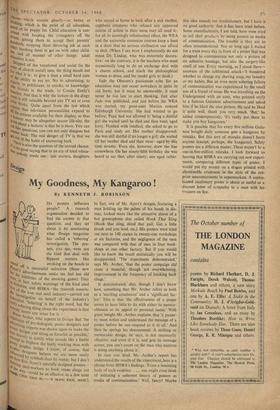b e .•
My Goodness, My Kangaroo !
By KENNETH J. ROBINSON Do posters influence people? A research organisation decided to find the answer to that question, and they set about it by conducting what Design magazine has called a 'sobering' investigation. The pos- ters, you see, were not the kind that deal with flippant matters like round smoking on the beach to Player, off a successful seduction (those new for the advertisements make me feel too old we' die subtleties of the smoking game). They ?' in fact, safety warnings of the kind used 1110oacte°ries, and BISRA—the research associa- the ,°` the iron and steel industry—carried out fed 'nvestigation on behalf of the industry's realeir4tion. 'Sobering' is the right word, but the onb'Y sobering thing about the experiment is that edy seems any wiser for it. exnertlee Archer, who reports in Design that 'the z,nv rie:Uce of psychologists, poster designers and tioate.rtIng experts was drawn upon to make the trif;f. designs and siting as forceful as possible,' orovelY to justify what sounds like a feeble OtetriltuPt to frighten the burly working man with trapL graphic design. I know, of course, that tte‘iileneed by junvfle designers believe we are more easily symbols than by words; but I don't wite„1:.)W Eric Ayers's specially designed posters- t"hing steel-workers to hook crane slings out words waY----could be as effective as a few terse ."`s n'trr THAT BL SLING BACK, MATE). In fact, one of Mr. Ayers's designs, featuring a man holding up the palms of his hands in dis- may, looked more like the attractive sleeve of a hot gramophone disc called Hook That Sling (Hook that sling, mind that pail; Get a little drunk and you land, etc.). His posters were tried out next to 140 cranes in twenty-one workshops at six factories, and the negligence of the men was compared with that of men in four work- shops at one other factory. But if you would like to know the result statistically you will be disappointed. 'The experiment demonstrated,' says Mr. Archer, 'that the poster campaign did cause a material, though not overwhelming, improvement in the frequency of hooking back slings.'
It demonstrated, also, though I don't know how, something that Mr. Archer refers to both as a 'startling conclusion' and a 'significant fac- tor.' This is that 'the effectiveness of a poster seems to have little to do with either its memor- ableness or its appeal to personal tastes.' With great insight Mr. Archer explains that 'a passer- by must notice and understand the message of a poster before he can respond to it at all.' And then he springs his denouement. A striking or memorable design, he says, is not necessarily effective; and even if it is, and gets its message across, you can't count on the man who receives it doing anything about it.
In case you think Mr. Archer's report has understated the results of the experiment, here is a phrase from BISRA's findings. 'From a mounting body of such evidence . . . one might even think of initiating a coherent theory of posters as media of communication.' Well, fancy! Maybe this idea sounds too revolutionary, but I have it on good authority that it has been tried before. Some manufacturers, I am told, have even tried to sell their products by using posters as media of communication. The trouble is they are so often misunderstood. Not so long ago I waited for a train every day in front of a poster that was designed to communicate not only a picture of an adhesive bandage, but also the surgery-like smell of one. Every morning, as I stood there— unaware of the subliminal attack-1 wondered whether to change my shaving soap, my laundry or my habits. But an even more sobering failure of communication was experienced by the small son of a friend of mine. He was travelling on the Underground with an aunt, who pointed coyly to a famous Guinness advertisement and asked him if he liked the nice picture. He said he liked it quite well, thank you very much. 'But,' he added contemptuously, 'it's really put there to make you buy kangaroos.'
It is possible that for every five million Guin- ness bought daily someone gets a kangaroo by mistake. But this sort of mistake doesn't harm anyone (except, perhaps, the kangaroo). Safety posters are a different matter. These mustn't be a one-in-five-million mistake. I look forward to hearing that BISRA are carrying out new experi- ments, comparing different types of poster. I would put my money on a slogan printed with abominable crudeness in the style of the cut- price announcements in supermarkets. A sophis- ticated cautionary poster is about as useful as a discreet letter of sympathy to a man with his trousers on fire.






































 Previous page
Previous page